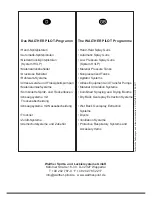
25
24
Always wear hearing protection when using the gun or when in the vicinity of a gun
that is in use. The noise level generated by the spray gun is approx. 84 dB (A).
After carrying out assembly or maintenance work, always ensure that all nuts, bolts
and screw connections have been fully tightened before the gun is used.
Use only original replacement parts, since WALTHER can only guarantee safe and
faultfree operation for original parts.
For further information on the safe use of the spray gun and the spraying materials,
please contact WALTHER Spritz- und Lackiersysteme GmbH, D-42327 Wuppertal,
Germany
4
Connection of Input Lines
Note
Use the exploded view at the beginning of these operating instructions to perform the
operational steps described hereafter.
Warning
The air pressure at the gun shall not exceed 8 bar; otherwise a safe operation of the
spray gun cannot be ensured.
Warning
The air hose which is installed with a hose grommet must be additonally secured with
a hose clamp.
1. Connect the air hose to the air outlet valve (cleaned compressed air) - or an air
cleaner - and to the air inlet of the spray gun (Item 20).
2. Fill the gravity-feed cup with screened material.
3. Close the gravity-feed cup.
4. Switch an the pneumatic system. The spray gun can then be taken into
operation.
5
Operational Handling
5.1
Safety Instructions
Pay special attention to the following safety warnings when using the spray gun!
•
Make sure to wear proper respiratory protection masks and protective overalls,
whenever you are operating this spray gun. Airborne particles represent a health
hazard.
•
Make sure to wear suitable hearing protectors. The spray guns produce sound
levels of approx. 84 dB (A).
•
Make sure your working area is absolutely free from open fires and naked lights
- and anybody smoking. Spraying of readily flammable media (e.g. lacquers) is
always accompanied by the risk of fire and explosion.
5.2
Starting / Stopping Requirements
The following requirements must be met beforethis spray gun can be taken into
operation:
•
The atomizing air pressure must be available at the gun.
Caution
The air pressure shal I not exceed 8 bar, as otherwise the functional reliability of the
spray gun will suffer.
Warning
It is important to remember that the spray gun must be relieved of all pressures when
work is terminated - lines left in pressurized condition could burst with their contents
likely to injure anybody standing nearby.
5.3
Spray Pattern Test
Spray pattern tests should be performed whenever:
•
the spray gun is taken into operation for the first time
•
the spraying medium is changed
•
the spray gun was taken apart for servicing or repairs.
The spray pattern is best tested using a workpiece sample, a sheet of metal, card-
board or paper.
Warning
When spraying materials, do not place your hands or other parts of the body in front
of the pressurised nozzle or the spray gun. Risk of injury!
Warning
Make sure that nobody is present in the spraying zone when the gun is started
- imminent risk of injury.
1. Start the gun to produce a spray pattern sample (see
5.2 Starting / Stopping
Requirements
).
2. Inspect the sample and adjust the settings of the gun, if necessary (see
5.4
Spray Pattern Adjustments
).
5.4
Spray Pattern Adjustments
The spray pattern of the PILOT IV and PILOT IV GM can be adjusted as follows.
Wide and / or Round Jet Pattern
The regulating screw (Item 21) controls the width of the jet. By turning it to the left a
wide-jet pattern will emerge; by screwing it to the right a round-jet pattern can be
achieved.



































